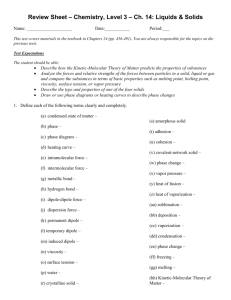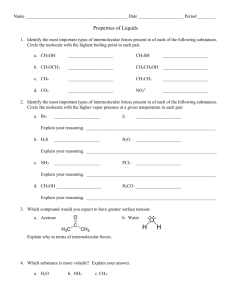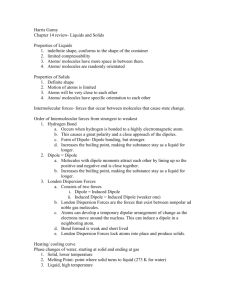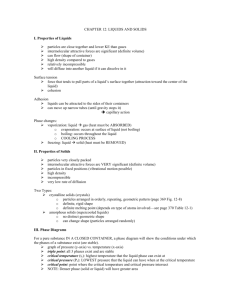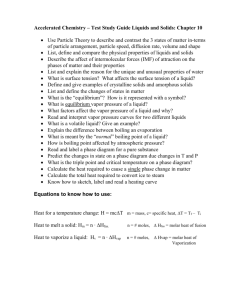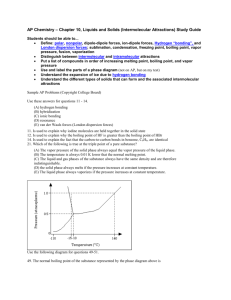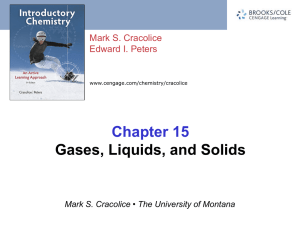Intermolecular Forces, Solids, and Liquids
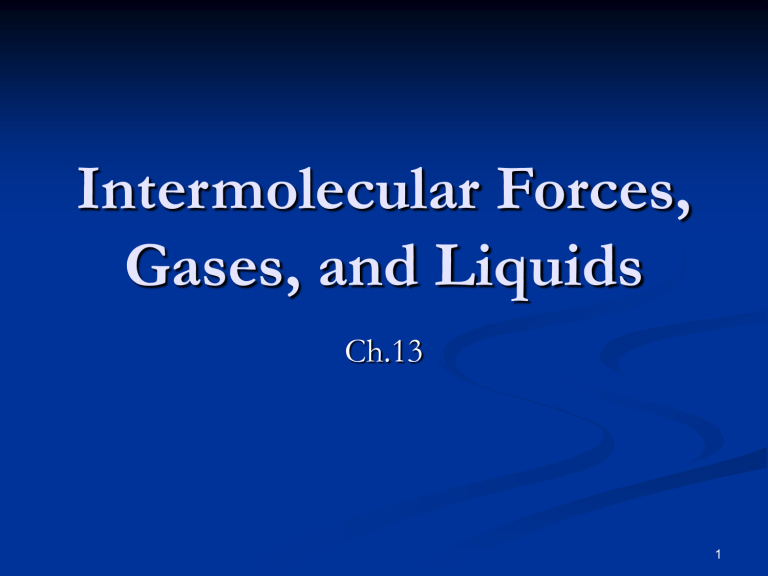
Intermolecular Forces,
Gases, and Liquids
Ch.13
1
Gases
Kinetic-Molecular Theory says molecules/atoms separated
Little, if any, interactions
Not so in solids and liquids
Examples:
Big difference in volume between liquids & solids and gases
Gases compressible, liqs & solids not
2
Intermolecular Forces
Various electrostatic forces that attract molecules in solids/liqs
Much weaker than ionic forces
About 15% (or less) that of bond energies
Remember, ionic bonds extremely powerful
Boiling pt of NaCl = 1465 ° C!
3
Intermolecular Forces
Reason behind importance of knowing about
IMF:
1) b.p. & m.p. and heats of vaporization (l g) and fusion (s l)
2) solubility of gases, liquids, and solids
3) determining structures of biochemicals
(DNA, proteins)
4
Remember dipole moments?
Dipole moment = product of magnitude of partial charges (+ / -) & their distance of separation
= (1 Debye = 3.34 x 10 -30 C x m)
Important in IMF
5
Ion-dipole: Ionization in aqueous medium (water)
1) stronger attraction if ion/dipole closer
Li + vs. Cs + in water
2) higher ion charge, stronger attraction
Be 2+ vs. Li + in water
3) greater dipole, stronger attraction
Dissolved salt has stronger attraction to water than methanol
6
7
Solvation energy
Or, enthalpy of hydration (if water) = energy of ionization in aq. media
Water molecules surround both ions
Example:
Take hydration energies of G I metal ions
Exothermicity decreases as you go down the column
Cations become larger
Easier to dissociate
8
Permanent dipoles
Positive end of one molecule attracted to negative end of other
For ex: HCl
Dipole-dipole attractions
Cmpds that exhibit greater d-d attractions have higher b.p., and H vap
Polar cmpds exhibit greater d-d attractions than non-polar cmpds
NH
3 vs. CH
4
equivalent molar masses (g/mol): 17 vs. 16, respectively
Boiling points: -33 ° C vs. -162 ° C, respectively
9
Hydrogen Bonding
A type of “super” dipole-dipole interaction
Interaction between e -rich atom connected to H entity & another H attached to e — rich atom e -rich atom = O, F, N
Density water > than ice
Opposite of almost every other substance
Inordinately high heat capacity of water
High surface tension
Insects walk on water
Concave meniscus
10
Hydrogen Bonding
Boiling pts. of H
2
O, HF, and NH
3
much higher
11
Surface Tension
Outer molecules interact with surface, while inner interact with other molecules
It has a “skin”
Skin toughness = surface tension
Energy required to break through surface
Smaller surface area reason that water drops spherical
12
Capillary Action
When water goes up a small glass tube
Due to polarity of Si-O bonding with water
Adhesive forces > cohesive forces of water
Creates a chain or bridge
Pulls water up tube
Limited by balancing gravity with adhesive/cohesive forces
Thus, water has a concave meniscus
13
Mercury
Forms a convex meniscus
Doesn’t “climb” a glass tube
Due to cohesive forces > adhesive forces
14
Viscosity
Hydrogen-bonding increases viscosity
But large non-polar liquids like oil have:
1) large unwieldy molecules w/greater intermolecular forces
2) greater ability to be entangled w/one another
Did you ever hear the expression, “You’re as slow as molasses in January”?
15
Dipole/Induced Dipole Forces
Polar entities induce dipole in nonpolar species like O
2
O
2
can now dissolve in water
If not, fishes in trouble!
Process called “polarization”
Generally, higher molar mass, greater polarizability of molecule
Why?
(larger the species, more likely e held further away easier to polarize)
16
Polarizability
17
Induced dipole/induced dipole forces
Non-polar entities can cause temporary dipoles between other non-polar entities
causing intermolecular attractions
Pentane, hexane, etc.
The higher the molar mass, the greater the intermolecular attractions
N-pentane has greater interactions than neo-pentane
Latter’s smaller area for interactions
I
2 has a higher H vap
& b.p. than other halogens cause nonpolar substances to condense to liquids and to freeze into solids
(when the temperature is lowered sufficiently)
Also called: London Dispersion Forces
18
Intermolecular Bonding Compared
Strength
Strongest: Ion-dipole
Strong: Dipole-dipole (incl. H-bonding)
Less strong: dipole/induced-dipole
Least strong: induced-dipole/induced-dipole (London dispersion forces)
Keep in mind a compound can have more than one of the above!
19
Problem
Rank the following in order of increasing boiling point and explain why:
NH
3
, CH
4
, and CO
2
20
Properties of Liquids
(l) (g)
Vaporization = endothermic
Condensation = exothermic
Boiling
Why do we have bubbles?
21
Vapor Pressure
Leave a bottle of water open….
Will evaporate
Keep the lid on….
can have equilibrium between liquid and gas
Equilibrium vapor
pressure/vapor pressure
Measure of tendency of molecules to vaporize at given temp.
22
What does this graph tell us?
23
Volatility
Ability of liquid to evaporate
Higher the vapor pressure, greater the volatility
Are polar cmpds or nonpolar cmpds of equal molecular mass more volatile?
24
Clausius-Clapeyron Equation
Calculates ∆H vap
What is this an equation for?
What are the variables?
C = constant unique to cmpd
R = ideal gas constant
8.314472 J/mol K
Ln P vap
-
H vap
R
1
T
C
25
Clausius-Clapeyron Equation
Or, if given two pts.: ln(
P
2 )
P
1
H vap
R
1
(
T
2
1
T
1
)
26
Clausius-Clapeyron Problem
Methanol has a normal boiling point of 64.6°C and a heat of vaporization of 35.2 kJ/mol.
What is the vapor pressure of methanol at
12.0°C?
Does the answer make sense?
Would water have a higher heat of vaporization?
Why?
Heat of vaporization of water = 40.65 kJ/mol
27
Boiling Point
Bp temp. at which vapor pressure = external
(atmospheric pressure)
At higher elevations atmospheric pressure is lower
Thus, water boils at less than 100 ° C
28
Critical Temperature and Pressure
As temp. rises so does vapor pressure, but not infinitely
At the critical point liq/gas interface disappears
Critical temp/pressure
T c
/T p
Gives supercritical fluid
Density of a liq
Viscosity of gas
H
2
O:
T c
= 374 ° C
T p
= 217.7 atm!
Normal earth pressure 1 atm
29
Supercritical fluid
CO
2 used in decaffeinating coffee
Read about it on page
614
30
Phase diagram
Gives info on phase states of a substance at varying pressures and temperatures
31
Deciphering a phase diagram
Triple point
Where all 3 states coexist
Curves denote existence of two states
Fusion (solid & liq)
Vaporization (liq & gas)
Sublimation (solid & gas)
Off the lines
Single state
32
Water’s phase diagram
Graph explains why water boils at lower temps at higher altitudes (next slide)
If you apply increasing pressure (const. T of 0°C) to ice will it convert to water?
Solid-liquid line has negative slope
It’s the opposite of most species
Why?
33
Sublimation
Going from solid to gas without going through the liquid state
Enthalpy of sublimation
H sublimation
Iodine & dry ice (solid
CO
2
) sublimate
Opposite of sublimation
Deposition (g s)
Iodine demo
34
CO
2
’s Phase Diagram
Explains sublimation
How?
Why is it called
“dry ice”?
35
Iodine’s Phase Diagram: But does it really sublimate?
36
Problem
The normal melting and boiling points of xenon are -112°C and
-107°C, respectively.
Its triple point is a -121°C and 0.371 atm and its critical point is at 16.6°C and 57.6 atm.
a) Sketch the phase diagram for Xe, showing the axes, the four points given above, and indicating the area in which each phase is stable.
b) If Xe gas is cooled under an external pressure of 0.131 atm, will it undergo condensation or deposition?
37

